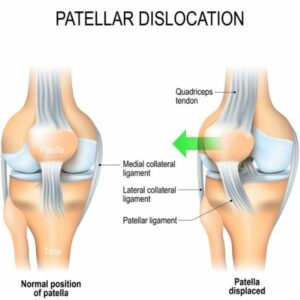Patellar Dislocation Specialist

Are you an athlete who participates in contact sports? If so, you may be at risk of sustaining a patellar dislocation. Patellar dislocation, or kneecap dislocation, is caused by an unnatural twist or direct impact to the knee. This can cause extreme pain, stiffness and swelling in the affected knee. Patella dislocation specialist, Dr. James Mazzara provides diagnosis and both surgical and nonsurgical treatment options for patients in Manchester, South Windsor, Enfield, Glastonbury and surrounding Hartford communities who have suffered a dislocated patella. Contact Dr. Mazzara’s team today!
Patellar Instability and Dislocation of the Knee
What is Patellar Instability?
The patella (kneecap) is attached by tendons to the femur (thigh bone) and the tibia (shin bone). The patella fits into a grove at the end of the femur called the trochlear groove. When the knee bends or straightens, the patella slides up and down. Patellar instability occurs when the patella moves outside of the trochlear groove. Patellar instability is almost always due to a dislocation in the knee. When the kneecap dislocates, structures inside the knee are torn; most commonly, the medial patellofemoral ligament (MPFL). Dr. James Mazzara specializes in treating patellar instability for patients living in Manchester, South Windsor, Enfield, Glastonbury and surrounding Hartford communities who experience continual kneecap dislocations.
What Causes Patellar Instability?
Patellar instability may slowly develop over time with daily activities. It can also be the result of a specific injury or event, such as a direct hit to the knee. If the patella is forced out of its groove, dislocation occurs; this is called a traumatic injury. Often, the kneecap returns to its correct position in the groove without intervention. If it does not return on its own, a procedure called a reduction can be performed by Dr. Mazzara.
Patellar instability can also be present without a specific injury when the kneecap comes partially out of the trochlear groove. This subluxation is called an atraumatic injury and happens when the kneecap does not stay in the appropriate place during daily activities.
In either situation, the knee will be painful and activity will be limited.
What are the Symptoms of Patellar Instability?
- Sensation of the kneecap slipping or moving with turning or rotating movements.
- Pain in the kneecap, especially with activity or when being palpated.
- Swelling and stiffness in the knee, especially following a traumatic incident.
- Weakness and limited range of motion in the joint.
- Hearing a popping sound when the patella dislocates.
- A change in the knee’s appearance with the knee looking misshapen or malformed.
How is Patellar Instability Diagnosed?
Dr. Mazzara will want to assess the degree of injury and determine the cause leading up to patellar instability and/or dislocation. Dr. Mazzara will perform a thorough medical history review and physical examination to determine the level of instability. Specially positioned knee x-rays are always necessary to evaluate for patellar alignment and evidence of bone injury from a previous dislocation. An MRI may be ordered instead to evaluate possible ligament and cartilage damage in the case of a traumatic dislocation. A CT scan in various degrees of knee flexion will be needed to determine the position of the patella as it moves from full extension (knee straight) to 45 degrees of knee flexion (knee bent about half way).
What is the Treatment for Patellar Instability and Dislocation?
In most cases, patellar instability can be treated without surgery. Patients who have a normal patellar height and do not damage the articular cartilage or bone are at low risk for recurrent patellar instability. Patients who have recurrent instability may need surgery to restore the stabilizing ligaments of the knee.
Does Patellar Instability Require Surgery?
- Immobilization: Wearing a brace for several weeks will allow the patella to heal while stabilizing the knee.
- Non-Weight bearing: Using crutches may be necessary for the first few weeks after a traumatic dislocation to facilitate healing of the patella without added stress to the joint.
- Physical Therapy: After a period of rest, physical therapy is recommended to strengthen the thigh muscles that keep the knee joint in place.
What is the Surgical Treatment for Patellar Dislocation?
For patellar instability with recurrent dislocation, or subluxation (partial dislocation or just a sense that the patella will slip), surgery may be recommended to correct the problem. The type of surgery will depend on the cause of the instability. Surgical treatments often involve reconstructing the ligaments that hold the patella in place. If possible, Dr. Mazzara will perform this surgery arthroscopically – using a small camera and small surgical instruments inserted through small incisions in the knee. An open surgery technique involves a slightly larger incision, giving Dr. Mazzara better access to the injured joint. Some patients may require more extensive surgery which can include reconstructing the torn ligaments as well as realigning the patella by relocating the attachment of the patella tendon just below the knee joint. This may involve cutting and shifting the bone at the upper tibia so that the patella is no longer pulled to the outside of the knee (laterally).
If you have questions regarding patellar instability or are having recurrent dislocations of the kneecap, please contact the orthopedic offices of Dr. James Mazzara, knee specialist in Manchester, South Windsor, Enfield, Glastonbury and surrounding Hartford communities.
